Unfortunately, due to low use from 4thWay's website users, we rarely update these detailed Insight Reports any more. Please see our Quick Expert Reviews in 4thWay's P2P lending comparison tables and see our latest guides, articles and research by visiting our Learn page.
If you would really find it useful to have reports like this, or other detailed reports in another format, please get in touch. We are very interested in how we can present you with all the information you want and need – in the way you want it – to educate yourselves about P2P lending opportunities.
This report was last updated on 8th September, 2016, with some minor updates on 30th November, 2016
Here is our detailed, candid Zopa review. Zopa is the oldest P2P lending website in the world, founded in 2005, and it is focused exclusively on unsecured personal loans.
If you're looking for one aspect in particular, glance through the contents on the far right.
Zopa review: interest rates and 4thWay® PLUS Ratings
Zopa has three lending products all of which automatically lend your money to individual borrowers in loans lasting 1-5 years:
Zopa Access: gives you easy access to your cash with no exit fee and a reserve fund to cover expected bad debts.
Zopa Classic: pays you more interest and there is a 1% early exit fee (although see “Exiting loans early” for a workaround), also with a reserve fund to cover bad debts.
Zopa Plus: a higher interest rate than Zopa Classic, with some slightly riskier borrowers thrown in, no reserve fund and a 1% early exit fee (although see “Exiting loans early” for a workaround).
[supsystic-tables id='25']
Only 6/64 platforms analysed by 4thWay's experts have earned 4thWay PLUS Ratings and Zopa is one of them. Our PLUS ratings, based on an internationally recognised risk-modelling methodology, reflect both the risk and reward. We believe platforms with PLUS Ratings are investment grade.
Zopa has been awarded our top two ratings of five PLUSes or four PLUSes for its Zopa Classic and Zopa Access accounts respectively.
Zopa Classic's five PLUSes score means that in a 1-in-100-year, major shock, such as a recession, we conservatively estimate Zopa lenders can expect to recover all their losses within two years, if they make a loss at all. It could potentially take up to a year longer to recover losses completely under Zopa Access due to its lower interest rate, which is why it has dropped a PLUS for a still highly investable four 4thWay PLUSes.
The Zopa Plus lending product hasn't yet received a 4thWay PLUS Rating. The single reason for this is that the product is new and Zopa hasn't yet updated the detailed data it sends us on the history of every single loan, so that we can separate out the risks of Zopa Plus loans. Once it has, we expect that this Zopa product will also earn a high PLUS Rating.
The 4thWay Risk Scores consider just our methodological assessment of the risks and not the accompanying rewards, i.e. we don't adjust them for interest earned. The lowest (best) score is 1 although no P2P lending platform can earn that, since it is the same risk as savings accounts. A score of 10 is the highest and it reflects that the risk is as high as some of the riskiest stock-market investments.
Zopa's risk score of 4 is very low. It shows that we believe losses before interest in a terrible recession would be limited to less than 5% after the bad-debt provision fund is depleted.
Read about the 4thWay PLUS Ratings and Risk Scores. The PLUS Ratings and Risk Scores are indicators, not guarantees. They assume that you can and do spread your money across lots of loans.
Key data points
You can see around 100 different Zopa statistics and facts by visiting 4thWay's comparison tables, selecting a Zopa product and then checking the box on the right to see more details. Here are some of the key items:
[supsystic-tables id='26']*No lenders have suffered losses from these bad debts because Zopa's reserve fund has covered them.
Zopa review highlights and lowlights
- Zopa has earned great 4thWay® PLUS Ratings
 due largely to focusing on lower-risk consumer borrowers, while having a long history with low bad debts and a fair sized bad-debt provision fund (reserve fund).
due largely to focusing on lower-risk consumer borrowers, while having a long history with low bad debts and a fair sized bad-debt provision fund (reserve fund). - Zopa's team has all the banking skills and experience that you would hope to see at a lending institution.
- Zopa is the oldest P2P lending company in the world; the one that started it all back in 2005, and also one of the the biggest.
- Bad debts (all paid so far by the reserve fund) are low; any bank would be proud of the results achieved by Zopa.
- In the event the bad-debt provision fund is overwhelmed by bad debts, lenders will take the hit from any additional bad debts that occur on their own loan parts, but we believe the risk of a large loss is very low.
- Interest rates at Zopa are currently a little bit lower than its closest competitors, because lenders don't demand such high rates from older, more trusted P2P lending companies.
- Zopa chooses your borrowers for you, the majority of which are “responsible” and “sensible” consumer borrowers.
- You can easily spread your money (and therefore your risks) across at least 100 borrowers by lending at least £1,000.
- Zopa has lots of lenders who want you to exit early so they can take over your loan parts, so we think exiting loans will normally be quick, but it depends on new lenders wanting to lend who can take over your loans.
- Because it has lots of lenders, at times, especially around Christmas when borrowers are borrowing less, it might take longer to lend your money. Currently it takes just a day or two to lend through Zopa Access and Zopa Plus, but Zopa Classic can be around 10 days.
- Zopa is simple and easy for anyone to use and understand.
- Zopa is a founding member of the Peer-to-Peer Finance Association. It has high standards of transparency.
- Zopa was backed by investors who also backed eBay, Betfair and Lovefilm.
- Zopa has recently been accepting a higher proportion of loan applicants and adding in a few more higher risk borrowers, in order to steady interest rates, speed up lending times and enable its business to grow further. This could also increase risks, but so far the results are still acceptable.
It takes a lot of time and money to produce high-quality research. If you want to re-use the thoughts, ideas or information within 4thWay's Zopa review commercially, journalistically, in comparison tables or in a blog, please see our terms and conditions. We do not provide financial advice or guarantees. See the bottom of this report for some key terms from our T&Cs on our liability.
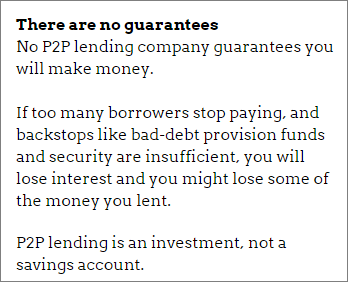 Who does Zopa lend to?
Who does Zopa lend to?
Zopa does consumer loans, which are relatively easy loans to measure the risks when reviewing loan applications. The intrinsic risk of such loans is therefore low and Zopa has all the necessary people and processes in place to select borrowers and price interest rates accordingly.
About Zopa's bad-debt rates
We estimate the average bad debt to occur each year (annual bad debt) is not much more than 1%, which is a great record.
Looking at recent loans compared to older loans, we see that bad debts have been rising over the past few years.
Part of the increase will be due to Zopa accepting a proportion of higher-risk borrowers. When a P2P lending company is small it can afford to be far more selective of its borrowers than it needs to be. Now that Zopa has matured, its risk level has been normalising, although it is still focused on better quality borrowers.
Another part of the increase can be explained by natural variations in the economy.
For example, if we take a snapshot at end July 2016 of total bad debts on loans that were issued in the previous year, 2015, so far around 1.4% is currently a bad debt. (The annual bad-debt rate is lower since most of these loans are now over 1 year old.)
Compare this by rewinding to July 2015 and looking at loans issued in the previous year, 2014. At that point in time, bad debts for 2014 were around half as much.
However, the more recent loans still have an acceptable amount of bad debt that we can expect, in a moderate economy, to easily be paid off by steadily earning interest over several years.
Zopa is currently forecasting 3.24% bad debts for loans issued in 2016, which is higher than the 2.88% forecast for 2015 loans, and 2.06% for 2014 loans. This is not annual bad debt, but bad debt over the life of those loans, so you will earn several years' of interest during that time. (Note that Zopa always contributes more to its bad-debt provision fund when it forecasts more bad debts.) Those forecasts will take into account the current economy and any increase in riskiness from injecting some riskier borrowers to the mix.
These forecasts do not seem unreasonable given the low debts experienced so far and we expect that, barring an economic downturn, Zopa will again have had lower bad debts than it forecast when the loans made in those years are all paid off.
All the above figures are more relevant to Zopa Access and Zopa Classic account holders. Zopa Plus lenders will have to wait until Zopa starts providing more information on the performance of its new Zopa Plus product, but we strongly expect bad debts here to be well contained.
You can see more on these lifetime bad-debt figures in the bad debts section of the detailed comparison tables.
We’re going to take a look at two key indicators of potential bad-debt trouble ahead: acceptance rates and arrears:
Acceptance rates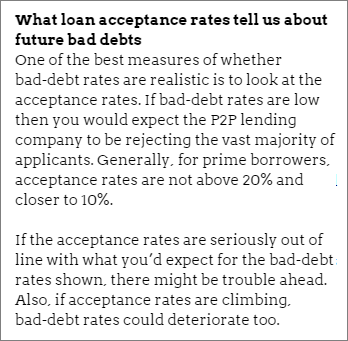
Zopa no longer has the luxury of rejecting 99.5% of borrowers, as it was able to do in 2005 simply because it was so small.
Over the years, Zopa has increased its acceptance rate to more normal levels. From around 2015 it told us its acceptance rate is around 20% of loan applications, which is a reasonable acceptance rate.
Zopa has not said what its loan-acceptance rate was through most of the 2010s, so we cannot see how drastic this increase is over, say, 2013 or 2014.
In January 2015, it also shifted its mix of borrowers slightly so that it accepts a higher proportion of loan applications a bit further up the risk scale.
That's not to say high risk, but higher risk than the very best borrowers.
That said, Zopa has been able to collect an awful lot more data about its borrowers over the past decade, so it might have learned how it can nudge up its loan acceptance rates, to an extent, with a relatively small increase in loans that go bad.
Late payments
The higher acceptance rate does not appear to have caused any worrying increase in late payments. Currently, late payments are incredibly low – virtually zero – on loans issued between 2012 and 2016.
Interest rates and repayments
Our Zopa review has seen Zopa's rates fall slowly over the year. Particularly as lenders have learned to trust the oldest P2P lending company in the world, there have been more lenders who want to lend, and so the demand has driven the price down. In lending terms, that means demand drive interest rates down.
Naturally they started too high, though, since at the beginning Zopa had to pay very attractive rates to convince sceptical earlier investors/lenders.
Currently we believe the Zopa Access and Zopa Classic accounts have interest rates that have fallen to fair value for the risks involved, with a large margin of safety to help cope with severe recessions, as reflected by the four and five PLUSes.
We have too little information on Zopa Plus. We would expect based on Zopa's top-class underwriting that the rates will reflect the risks, but we wait for them to provide full details.
Zopa changes its interest rates irregularly. They're based on supply-and-demand, with more borrowers pushing rates up and more lenders pushing them down. Zopa says its interest rates are also impacted by what the banks are offering: for example, in 2016 it slightly lowered its rates at the same time that high-street banks did to ensure it can still attract the best borrowers.
You will receive monthly loan repayments, including some of the money you lent plus some interest.
[supsystic-tables id='27']*No lenders have suffered losses from these bad debts because Zopa's reserve fund has covered them.
Exiting loans early
Unless you lend through Zopa Access, Zopa charges you a 1% fee for leaving your loan early, but quitting a P2P loan is not as simple as withdrawing your savings from your bank.
Your loan has to be bought by someone else. This won't normally take long with Zopa, because there are a lot of lenders who want to buy you out.
You won't be able to sell loans that are currently being repaid late or if Zopa is in the process of collecting a payment from that borrower.
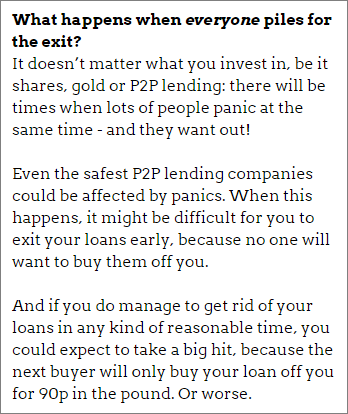 Making it up to the next lender
Making it up to the next lender
There's a second, potential cost for leaving early. Let's say that someone wants to lend through Zopa just as you're leaving. Zopa can transfer your loan parts to the new lender and pay you your money back.
But if Zopa is currently promising new lenders a higher rate today than when you bought the loan, your new lender will lose out by taking your loan parts.
So you have to make it up to the lender from your own money. That's why you might find that you get back, say, 95p in the pound.
On the other hand, Zopa won’t adjust the other way, by giving you more money if interest rates have fallen. So you can't profit from your exit.
A simple workaround
One way to withdraw your money without paying exit fees or compensating newer lenders when rates are rising is to switch off the automatic re-lending facility. This means that you will receive monthly repayments from your borrowers until it is all repaid.
A good proportion of borrowers repay their whole loan early, since they are not charged extra to do so.
Ease of lending
When choosing one or more P2P lending companies to lend through, one key criteria for many individual lenders is how easy it is to lend their money, and then to re-lend it when repayments are received.
Easily automate your lending
Zopa has incredibly simple automation options: automatic lending, automatic re-lending and automatic selling.
You can lend in all three Zopa products simultaneously, but you can just select one for automatic lending of new money that you deposit.
For each Zopa product that you are already lending through, you can simply and easily choose to re-lend repayments and interest you receive from borrowers automatically. Or you can choose for it to go into your Zopa holding account, so that you can either withdraw it as cash or re-lend the money in a different Zopa product.
To exit early by selling existing loans, all you have to do is type in the amount you want to sell. Zopa will estimate how much it will cost to sell the available loan parts, and you just have to accept the estimate and wait for the sale to happen.
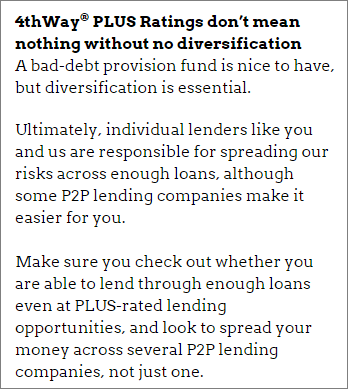 Spreading your risks – diversification
Spreading your risks – diversification
The more widely your money is spread the safer you are from bad luck.
Zopa will lend at most £10 to each of your allocated borrowers up to £1,000 of lending, meaning if you lend £1,000 then you are lending to at least 100 borrowers.
Since you receive partial repayments on a monthly basis, when you re-lend that money, Zopa could then diversify it across an even greater number of borrowers.
Borrower selection – underwriting
You want to see a team that convinces you it is experienced and that it conducts adequate checks on borrowers, so that it can select wisely and set appropriate interest rates for the borrowers. (Higher interest rates for riskier borrowers mean Zopa can pay you more interest for the risks you take and contribute more to the bad-debt provision fund for those loans.)
While loans are unsecured, the focus for Zopa is on getting responsible borrowers who are likely to be able to repay you. They could earn as little as £12,000, but more typically they earn between £30,000 and £40,000.
Zopa has a great team and processes. It seems to understand its customers, particularly after more than a decade. It has usually ended up with noticeably less bad debt than it forecast and its bad-debt provision fund has remained well stocked.
Can you select better borrowers yourself?
At Zopa, you cannot select borrowers yourself. This takes away the fun for many lenders, who want to try and pick better borrowers at higher interest rates – although that is usually very difficult.
Zopa still lets you see some details about the loans assigned to you, such as the purpose of the loan and whether there have been any late payments.
Deal-making potential
Since you can’t select borrowers, there is little deal-making potential at Zopa, so you can never expect to make extraordinary gains through horse trading. The corollary is that you shouldn’t expect extraordinary losses.
Technology
Zopa uses secure authentication both before and after you log in to your online account. This is a basic, vital safety feature that a surprising number of websites overlook.
Zopa is a modern financial technology company that has been around for over a decade. It has had no bad press from failure of technology.
While there are no guarantees, we don’t consider technology to be a big risk at Zopa.
Transparency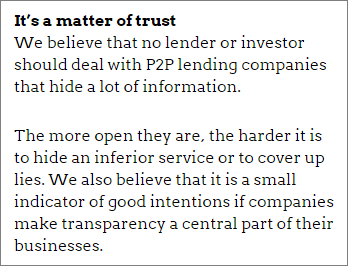
Zopa does a great job of providing key statistics on its website and it answers most of our questions clearly and candidly.
Importantly for our risk modelling, stress tests and ratings, it provides a detailed loan book, updated most months, showing the complete history of every single loan every made through Zopa.
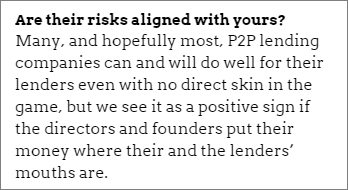 Skin in the game
Skin in the game
As far as we know, like most P2P lending companies (and most other investments for that matter) Zopa's founders do not share lenders' risks directly by lending in all the loans that are matched in its service.
What happens if Zopa goes bust?
Zopa is regulated by the UK's Financial Conduct Authority and is a member of the Peer-to-Peer Finance Association.
It has set up a trustee to run down all your loans in an orderly fashion if it goes out of business.
Loan fees will cover the costs of running the loans in that situation. If more money is required, it will come out of your interest and/or the bad-debt provision fund. If even more money is required, you might not receive all your loan money back, although in this unfortunate event you wouldn't expect to lose many pence for each pound lent.
What if you make a loss on your loans?
You loans are not protected by the government through the Financial Services Compensation Scheme (FSCS). If you suffer losses from bad debts, you are not covered any more than you are when you lose money on the stock market.
When your money is not on loan, it will be held in an account at a high-street bank (as of 2014 that is Royal Bank of Scotland), and kept separate from Zopa's own funds. In the event the bank fails, this money and all your other deposits at the bank (and other banks in the group that share the same banking licence) are protected by the FSCS up to £85,000.
Financial health
Zopa has been a very successful growth story in its decade of life and it is well backed by its investors.
Zopa's most recent accounts (up to 31 December 2015) show it has net assets (that means its cash and other assets minus its debts) of over £14 million, up from just £1 million a few years ago. Most of its assets are cash in the bank.
It has made a small profit in 2012 and then losses since 2013, with a loss of £9 million in 2015. However, Zopa is growing fast with revenue doubling to £21 million last year, and it is normal in any industry for rapidly growing, new companies (or relatively new in Zopa's case) to make losses as they spend to expand.
We currently think that Zopa, with its leading brand and quality people, will continue to survive and thrive, and see no reason to contradict its auditors in describing the company as a “going concern”.
Accuracy
There’s always the risk, for all companies, that their information is inaccurate. And we can never be sure that a company is fault or fraud free. However, we have seen no signs to indicate possible significant errors in Zopa's numbers or statements.
Costs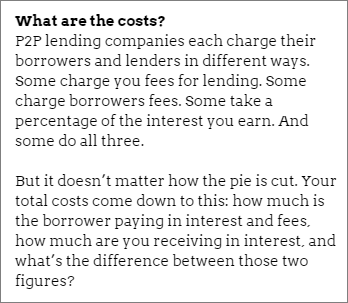
Since you are the lender, the borrower owes you, not Zopa.
You, in turn, owe Zopa for managing your little lending business.
So the difference between what the borrower pays and what you receive are your total costs. This is often called the “spread”.
The costs you're paying here go towards carrying out all the services that you can't do yourself: checking borrowers thoroughly, collecting on debts, admin, sales and much more.
Another part of the cost will go towards growing the provision fund on your behalf.
The final part of the cost will be Zopa's cut for providing its services and to cover any costs for themselves, such as sales and marketing.
What's the bottom line?
Zopa, like the majority of P2P lending sites, does not provide enough information to estimate its costs.
Important!
- We do not provide personal financial advice and no opinions expressed on or through this website are to be taken as personal financial advice.
- While we try to be as accurate as possible, we can accept no responsibility for any direct or indirect losses if any information on this website proves to be incorrect.
- It is a big challenge rating investments accurately, not least because we rely on data and information from P2P lending companies and others. That's why, while the 4thWay® PLUS Ratings and Risk Scores are objective measures that we are proud of and are working to improve all the time, they are not infallible.
- There are always additional outside risks that most of us just aren’t rich enough to plan properly for. Crazy as it sounds, maybe there’ll be a nuclear war, anarchy or some other big disaster. We can’t measure such risks, nor can we say whether having your money in a savings account would have been any safer.
See our full terms and conditions of use.
Our service is free to you. We don't receive commission or fees from the above-mentioned companies. We receive compensation from some other P2P lending companies when you click through from our website and open accounts with them, or to cover the costs of conducting our calculated stress tests and ratings assessments. This doesn't affect our editorial independence. Read How we earn money fairly with your help.



